2014.5 Peugeot Bipper steering wheel
[x] Cancel search: steering wheelPage 116 of 192
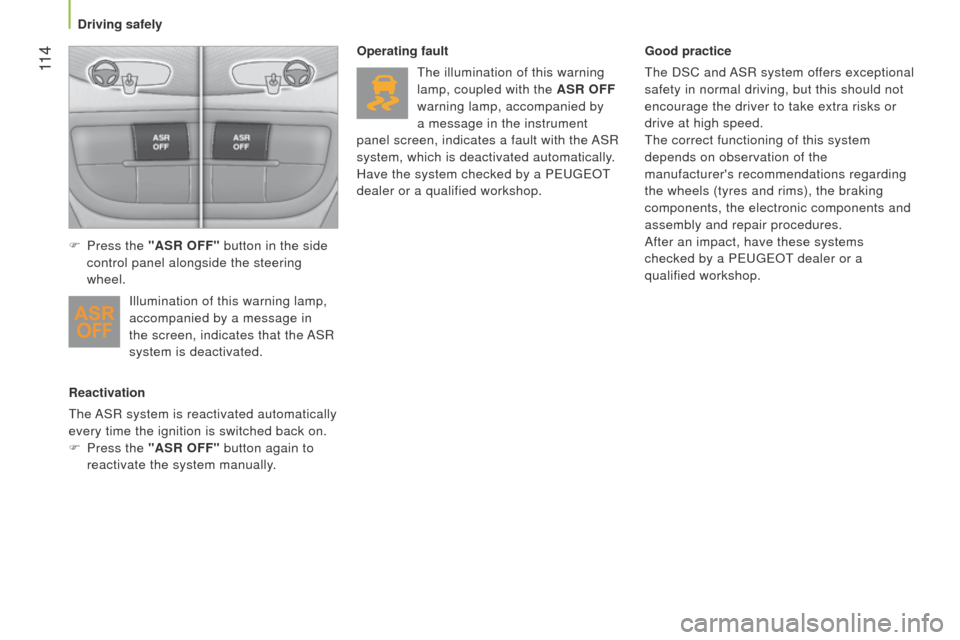
11 4
Bipper_en_Chap06_securite_ed02-2014
Reactivation
t
he ASR system is reactivated automatically
every time the ignition is switched back on.
F
Press the
"ASR OFF" button again to
reactivate the system manually. Operating fault
t
he illumination of this warning
lamp, coupled with the ASR OFF
warning lamp, accompanied by
a message in the instrument
panel screen, indicates a fault with the ASR
system, which is deactivated automatically.
Have the system checked by a P euge O t
dealer or a qualified workshop. Good practice
t
he DSC and ASR system offers exceptional
safety in normal driving, but this should not
encourage the driver to take extra risks or
drive at high speed.
t
he correct functioning of this system
depends on observation of the
manufacturer's recommendations regarding
the wheels (tyres and rims), the braking
components, the electronic components and
assembly and repair procedures.
After an impact, have these systems
checked by a P euge O t
dealer or a
qualified workshop.
F
Press the
"ASR OFF" button in the side
control panel alongside the steering
wheel.
Illumination of this warning lamp,
accompanied by a message in
the screen, indicates that the ASR
system is deactivated.
Driving safely
Page 117 of 192
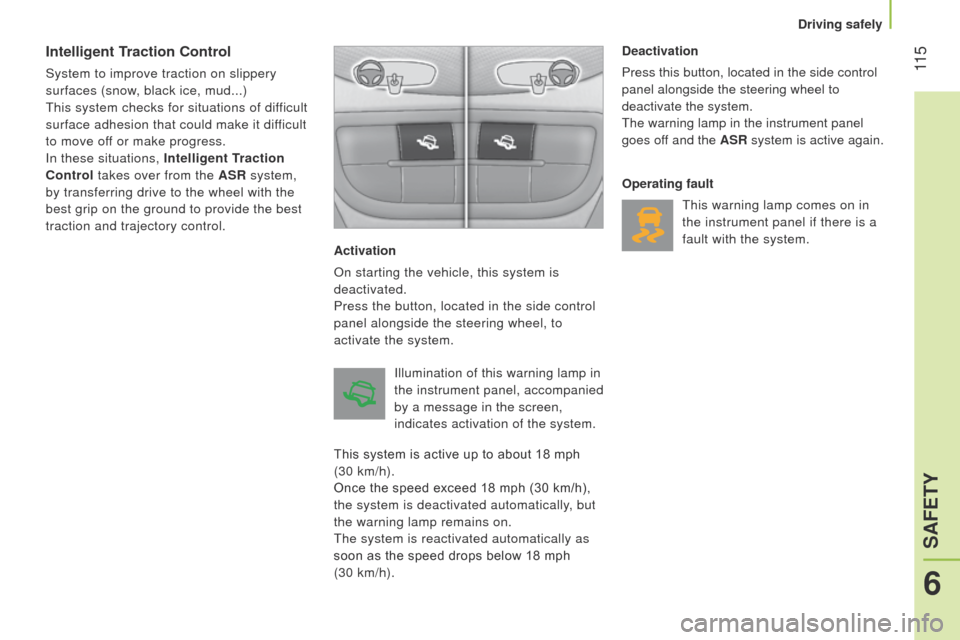
11 5
Bipper_en_Chap06_securite_ed02-2014
Intelligent Traction Control
System to improve traction on slippery
surfaces (snow, black ice, mud...)
t
his system checks for situations of difficult
surface adhesion that could make it difficult
to move off or make progress.
In these situations, Intelligent Traction
Control takes over from the ASR system,
by transferring drive to the wheel with the
best grip on the ground to provide the best
traction and trajectory control.
Activation
On starting the vehicle, this system is
deactivated.
Press the button, located in the side control
panel alongside the steering wheel, to
activate the system.Deactivation
Press this button, located in the side control
panel alongside the steering wheel to
deactivate the system.
t
he warning lamp in the instrument panel
goes off and the ASR system is active again.
Operating fault
t
his warning lamp comes on in
the instrument panel if there is a
fault with the system.
Illumination of this warning lamp in
the instrument panel, accompanied
by a message in the screen,
indicates activation of the system.
This system is active up to about 18 mph
(30 km/h).
Once the speed exceed 18 mph (30 km/h),
the system is deactivated automatically, but
the warning lamp remains on.
t
he system is reactivated automatically as
soon as the speed drops below 18 mph
(30 km/h).
6
SAFETY
Driving safely
Page 118 of 192

11 6
Bipper_en_Chap06_securite_ed02-2014
TYRE UNDER-INFLATION DETECTION
System which automatically checks the
pressure of the tyres while driving.
t
he system monitors the pressures on the
four tyres, once the vehicle is moving.
It compares the information given by the
four wheel speed sensors with reference
values, which must be reinitialised every
time the tyre pressures are adjusted or a
wheel changed.
t
he system triggers an alert as soon as it
detects a drop in the inflation pressure of
one or more tyres.
t
he under-inflation detection system
does not replace the vigilance or the
responsibility of the driver.
t
his system does not avoid the need to
check the tyre pressures (including the
spare wheel) every month as well as before
a long journey.
Driving with under-inflated tyres impairs
road holding, extends braking distances and
causes premature tyre wear, particularly
under arduous condition (high loading, high
speed, long journey).
Driving with under-inflated tyres increases
fuel consumption.
t
he inflation pressures defined for
your vehicle can be found on the tyre
pressure label.
See the "Identification markings" section.
tyre pressures should be checked when the
tyres are "cold" (vehicle stopped for 1 hour
or after a journey of less than 6 miles
(10 km) at moderate speeds).
Otherwise (when hot), add 0.3 bar to the
pressures shown on the label.
Under-inflation alert
This is given by fixed
illumination of this warning lamp,
accompanied the display of a
message,depending on equipment.
F
Reduce speed immediately
, avoid
excessive steering movements and
sudden braking
F
Stop the vehicle as soon as it is safe to
do so.
t
he loss of pressure detected does
not always cause visible bulging of the
tyre. Do not satisfy yourself with just a visual
check.
F
In the event of a puncture, use the
temporary puncture repair kit or the spare
wheel (depending on equipment),
or
F
if you have a compressor
, such as the
one in the temporary puncture repair kit,
check the pressures of the four tyres
when cold,
or
F
if it is not possible to make this check
immediately, drive carefully at reduced
speed.
t
he alert is maintained until the system
is reinitialised.
Driving safely
Page 124 of 192
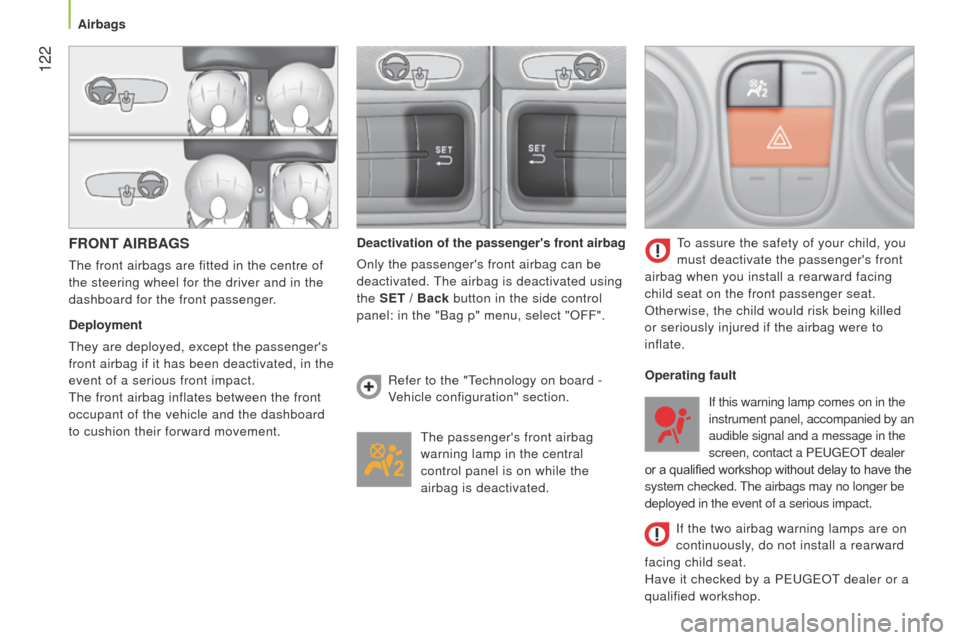
122
Bipper_en_Chap06_securite_ed02-2014
FRONT AIRBAGS
the front airbags are fitted in the centre of
the steering wheel for the driver and in the
dashboard for the front passenger.
Deployment
t
hey are deployed, except the passenger's
front airbag if it has been deactivated, in the
event of a serious front impact.
t
he front airbag inflates between the front
occupant of the vehicle and the dashboard
to cushion their forward movement. Deactivation of the passenger's front airbag
Only the passenger's front airbag can be
deactivated. t
he airbag is deactivated using
the SET / Back button in the side control
panel: in the "Bag p" menu, select "OFF".
t
he passenger's front airbag
warning lamp in the central
control panel is on while the
airbag is deactivated.
to assure the safety of your child, you
must deactivate the passenger's front
airbag when you install a rearward facing
child seat on the front passenger seat.
Otherwise, the child would risk being killed
or seriously injured if the airbag were to
inflate.
Refer to the "
t
echnology on board -
Vehicle configuration" section. Operating fault
If the two airbag warning lamps are on
continuously, do not install a rearward
facing child seat.
Have it checked by a P
euge O t
dealer or a
qualified workshop. If this warning lamp comes on in the
instrument panel, accompanied by an
audible signal and a message in the
screen, contact a P
euge O t
dealer
or a qualified workshop without delay to have the
system checked.
t
he airbags may no longer be
deployed in the event of a serious impact.
Airbags
Page 125 of 192
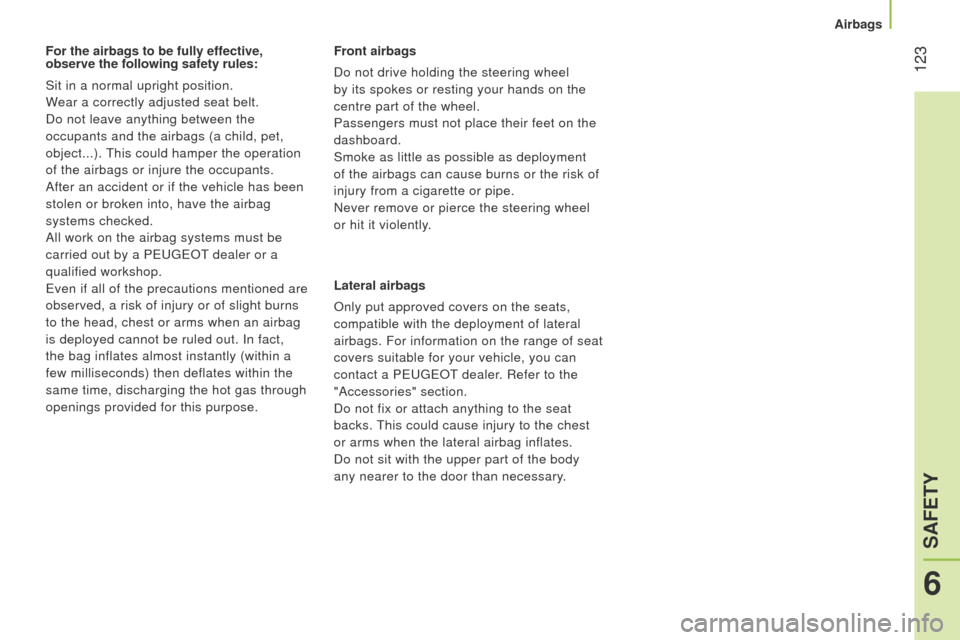
123
Bipper_en_Chap06_securite_ed02-2014
For the airbags to be fully effective,
observe the following safety rules:
Sit in a normal upright position.
Wear a correctly adjusted seat belt.
Do not leave anything between the
occupants and the airbags (a child, pet,
object...).
t
his could hamper the operation
of the airbags or injure the occupants.
After an accident or if the vehicle has been
stolen or broken into, have the airbag
systems checked.
All work on the airbag systems must be
carried out by a P
euge O t
dealer or a
qualified workshop.
e
ven if all of the precautions mentioned are
observed, a risk of injury or of slight burns
to the head, chest or arms when an airbag
is deployed cannot be ruled out. In fact,
the bag inflates almost instantly (within a
few milliseconds) then deflates within the
same time, discharging the hot gas through
openings provided for this purpose. Front airbags
Do not drive holding the steering wheel
by its spokes or resting your hands on the
centre part of the wheel.
Passengers must not place their feet on the
dashboard.
Smoke as little as possible as deployment
of the airbags can cause burns or the risk of
injury from a cigarette or pipe.
Never remove or pierce the steering wheel
or hit it violently.
Lateral airbags
Only put approved covers on the seats,
compatible with the deployment of lateral
airbags. For information on the range of seat
covers suitable for your vehicle, you can
contact a P
euge O t
dealer
. Refer to the
"Accessories" section.
Do not fix or attach anything to the seat
backs.
t
his could cause injury to the chest
or arms when the lateral airbag inflates.
Do not sit with the upper part of the body
any nearer to the door than necessary.
6
SAFETY
Airbags
Page 174 of 192
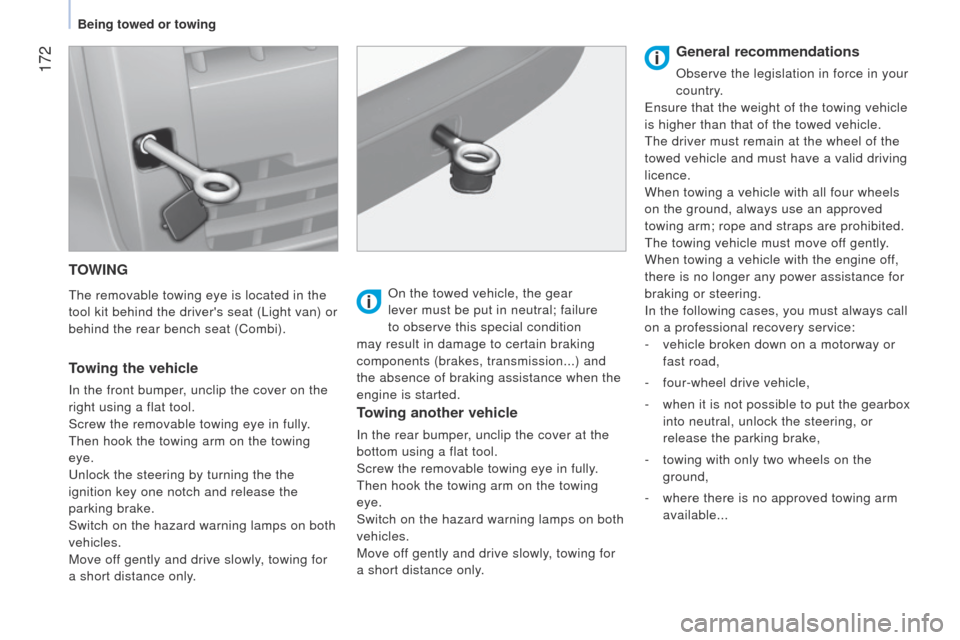
172
Bipper_en_Chap09_aide-rapide_ed02-2014
TOWING
the removable towing eye is located in the
tool kit behind the driver's seat ( l ight van) or
behind the rear bench seat (Combi).
Towing the vehicle
In the front bumper, unclip the cover on the
right using a flat tool.
Screw the removable towing eye in fully.
t
hen hook the towing arm on the towing
eye.
u
nlock the steering by turning the the
ignition key one notch and release the
parking brake.
Switch on the hazard warning lamps on both
vehicles.
Move off gently and drive slowly, towing for
a short distance only. On the towed vehicle, the gear
lever must be put in neutral; failure
to observe this special condition
may result in damage to certain braking
components (brakes, transmission...) and
the absence of braking assistance when the
engine is started.
Towing another vehicle
In the rear bumper, unclip the cover at the
bottom using a flat tool.
Screw the removable towing eye in fully.
t
hen hook the towing arm on the towing
eye.
Switch on the hazard warning lamps on both
vehicles.
Move off gently and drive slowly, towing for
a short distance only.
General recommendations
Observe the legislation in force in your
country.
e
nsure that the weight of the towing vehicle
is higher than that of the towed vehicle.
t
he driver must remain at the wheel of the
towed vehicle and must have a valid driving
licence.
When towing a vehicle with all four wheels
on the ground, always use an approved
towing arm; rope and straps are prohibited.
t
he towing vehicle must move off gently.
When towing a vehicle with the engine off,
there is no longer any power assistance for
braking or steering.
In the following cases, you must always call
on a professional recovery service:
-
vehicle broken down on a motorway or
fast road,
-
four-wheel drive vehicle,
-
when it is not possible to put the gearbox
into neutral, unlock the steering, or
release the parking brake,
-
towing with only two wheels on the
ground,
-
where there is no approved towing arm
available...
Being towed or towing